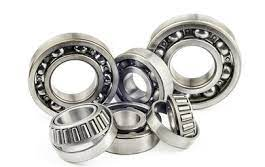Bearing Material
When a lubricant film cannot completely separate the moving parts of a bearing, friction and wear increase. The resulting frictional heat combined with high pressure promotes localized welding of the two rubbing surfaces.
These welded contact points break apart with relative motion and metal is pulled from one or both surfaces decreasing the life of the bearing.
This friction and welding is most common when like metals, such as steel or cast iron, are used as bearings – they easily weld together. Compatibility of bearing materials, therefore, and absorption of lubricant upon the bearing surface, is necessary to reduce metallic contact and extend bearing life.
Babbitt In 1839, Isaac Babbitt received the first patent for a white metal alloy that showed excellent bearing properties. Since then, the name babbitt has been used for other alloys involving similar ingredients.
Babbitts offer an almost unsurpassed combination of compatibility, conformability, and embedability. They easily adapt their shapes to conform to the bearing shaft and will hold a lubricant film. Foreign matter not carried away by the lubrication is embedded below the surface and rendered harmless.
These characteristics are due to babbitt’s hard/soft composition. High-tin babbitts, for example, consist of a relatively soft, solid matrix of tin in which are distributed hard copper-tin needles and tin-antimony cuboids.
This provides for “good run-in” which means the bearing will absorb a lubricant on the surface and hold the lubricant film. Even under severe operating conditions, where high loads, fatigue problems, or high temperatures dictate the use of other stronger materials, babbitts are often employed as a thin surface coating to obtain the advantages of their good rubbing characteristics.
Classification of Bearing Material
1. Tin Based Babbitt
2. Lead based Babbitt
3. Cadmium Based Bearing Material
4. Copper based Bearing Material (Cintered Metal)
Composition & uses of different type of Bearing material
1. Tin Based Babbitt
Compositions
85Sn-10Sb-5Cu
Applications
High speed bearing bushes in steam and gas turbine, electric motor, blower, pumps etc.
2. Lead Based Babbitt
Compositions:
80Pb-12Sb-8Sn
Applications:
Railway Wagon bearing.
3. Cadmium Based
Compositions:
95cd-5ag & small amount of iridium
Applications:
Medium loaded bearing subjected to high temperature
4. Copper Based
80Cu-10Pb-10Si
Applications
Heavy duty bearing.
Properties of Bearing Material
A bearing metal should possess the following important properties.
i) It should have enough compressive and fatigue strength to possess adequate load carrying capacity.
ii) It should have good plasticity for small variations in alignment & fittings.
iii) It should have good wear Resistance to maintain a specified fit.
iv) It should have low co-efficient of frictim to avoid excessive heating.
v) The material should resist vibration.
vi) It should have high Thermal conductivity so as to take away the heat produced due to friction between two moving parts.
vii) It should have the properties to from a continuous thin film of lubricant between the shaft & bearing to avoid direct contact between two rotating surface.
 |
| Bearing Material |